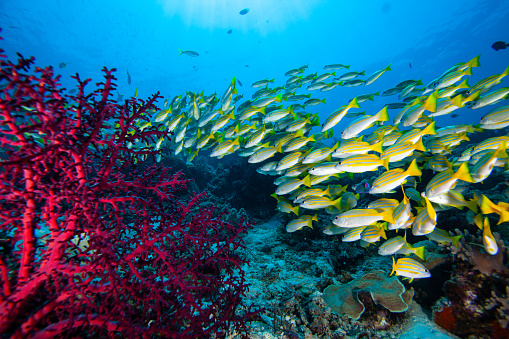Raja Ampat, located off the coast of West Papua, attracts scuba divers from all over the world. Due to strong currents, even the most experienced divers may find this underwater paradise difficult to navigate. You’ll learn what to look out for, west Papua diving sites for beginners and whether you need to dive extra before you go. In Raja Ampat, anyone can learn to dive, but for the purposes of this article, a novice diver is someone who has made about 20 dives.

Why is west Papua diving sites a difficult place to dive?
Raja Ampat is located at the confluence of the Indian and Pacific Oceans. The Indonesian Throughflow, which transports huge amounts of water between the islands, causes strong currents that can be difficult to navigate. These currents, of course, are what feed the wonderful reef systems and keep the biodiversity at such a high level.
Because of the currents, divers must be skilled drift divers, which isn’t something most beginners can do. Down currents can be very powerful, and for divers who aren’t used to drift diving, they can be rather frightening. Raja Ampat is also remote, and dive locations are typically far from medical assistance.
West Papua Best Dives for Beginners
However, you can dive in Raja Ampat provided you have a PADI Open Water certification. Before you enter the water, the dive guides will check your ability level. They would never take a diver to a spot that was beyond their ability or comfort zone.
Make sure you have complete confidence in your scuba equipment before booking a dive trip to Raja Ampat. A prerequisite is a confidence in a controlled descent and ascension. You should also be able to manage your buoyancy and monitor your air use. These may appear to be basic skills, but they must be mastered prior to diving in Raja Ampat.
Are you ready diving in West Papua Raja Ampat?
You’ll have the highest chance of having stunning dives if you choose the time of year with the best diving conditions.
When planning a vacation to a tropical dive destination like Raja Ampat, one of the first things you’ll think about is the weather. The equatorial environment maintains consistent temperatures throughout the year. Highs will be in the low 30s, and lows will be in the mid 20s. This indicates that the water temperature is between 28 and 29 degrees Celsius, which is ideal for diving.
Raja Ampat’s rainy season isn’t as dependable as it is on some of Indonesia’s other islands. Between June and September, there is normally more rain, but this does not mean that it rains every day during this time and not at all during other months.
During the rainy season, visibility may be reduced slightly. However, given the visibility in Raja Ampat is superb, this shouldn’t have a significant impact on your dives. Throughout the year, expect to see between 9 and 20 meters.
If you’re planning to dive to Raja Ampat during the rainier months of June to September, one thing to keep in mind is the wind. Rougher seas might likewise be more difficult to navigate for inexperienced dives. However, because many liveaboards cease their excursions at this time of year, experienced divers may decide to dive at Raja Ampat.
The months of October to April are generally considered to be the best because there is less rain and the waves are at their calmest. Raja Ampat, on the other hand, does not have an off season. The air and water temperatures are pleasant all year, and underwater visibility is great. A few rain showers can’t possible ruin your holiday when you’re in such a beautiful setting.